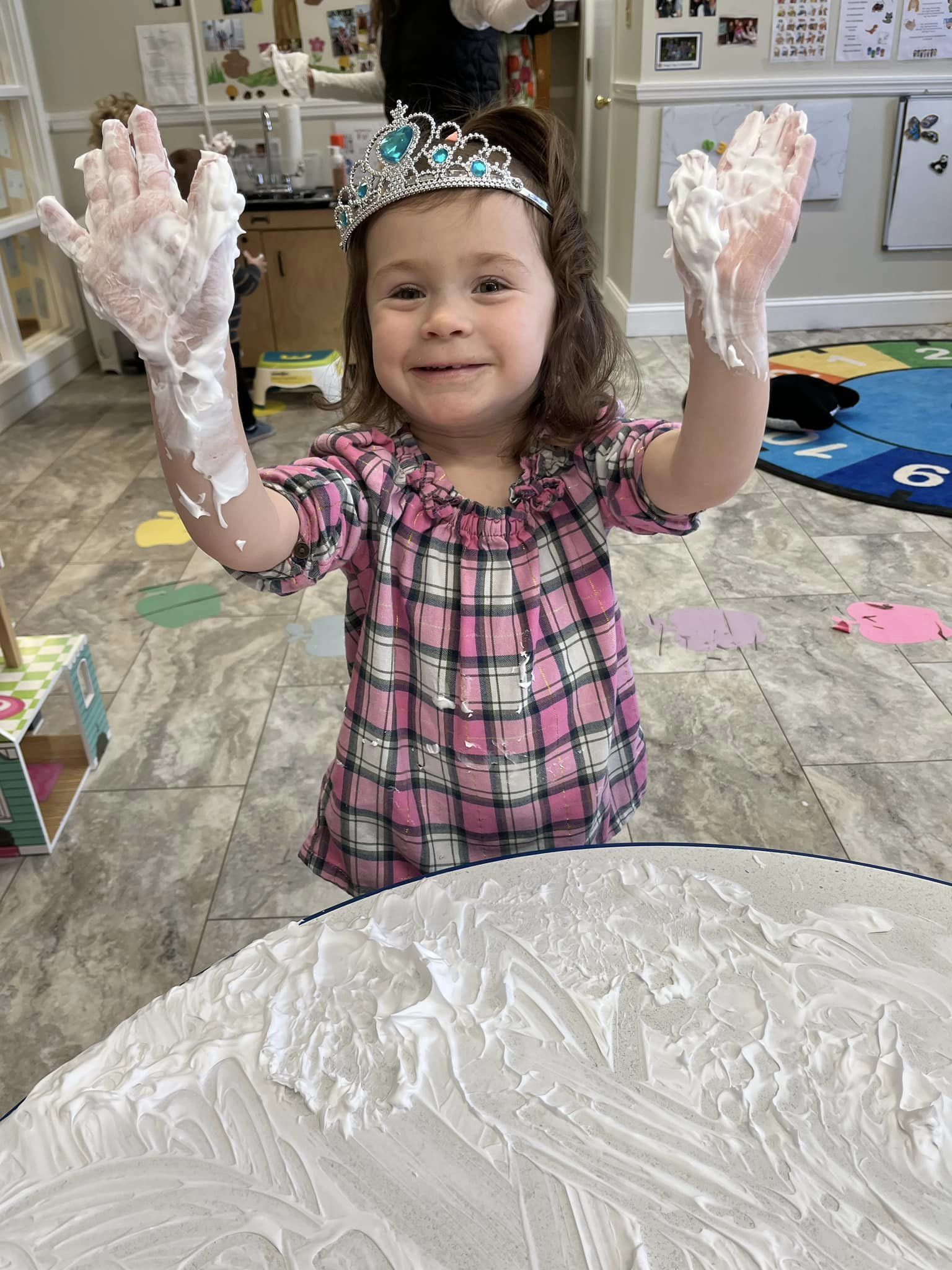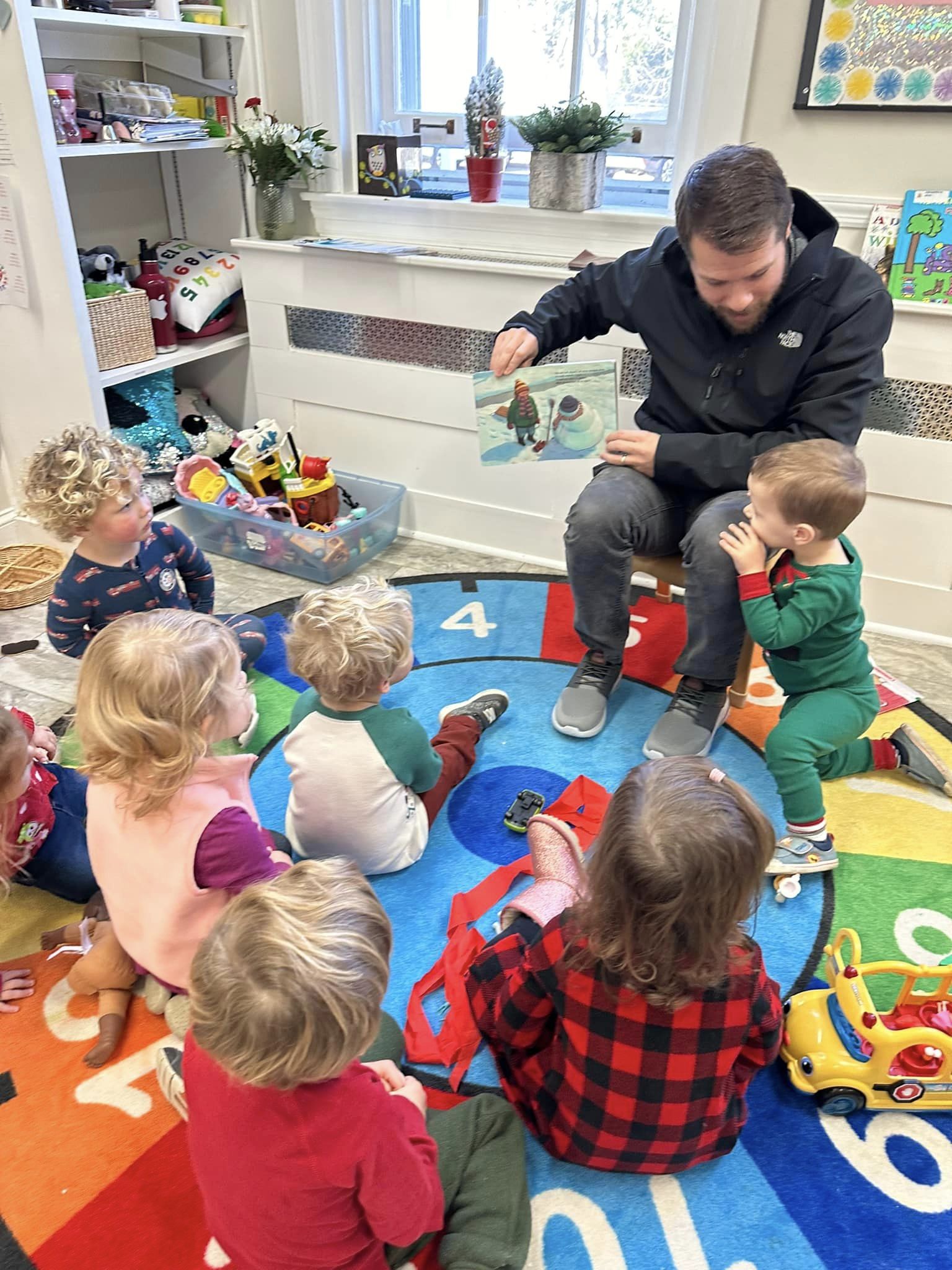


2-Day 2’s
Tuesday & Thursday, 9:00 am – 12 Noon
3-Day 2’s
Monday, Wednesday & Friday 9:00 am –12 Noon
Children must be 24 months by December 31st of the enrollment year.
2-Year-Old Curriculum Overview
The Presby 2’s curriculum focuses on sensory and social development, exploration and discovery. Based on a STEM/STEAM philosophy, students engage in structured and unstructured play, experiential learning, pre-literacy opportunities, music and art. Additionally, fine and gross motor activities are incorporated to provide a multi-sensory approach to learning. Above all Presby 2’s have fun and make friends!
2’s Curriculum
Cognition
- Curiosity and Initiative
- Ask questions and seek answers from a variety of sources
- Engagement with Environment, People and Objects
- Maintain interest in self-selected activities and may seek to engage other or ask questions
- Cause and Effect
- Vary actions to observe different results (i.e., hot lever harder to see if results change)
- Attributes, Sorting and Patterns
- Identify differences between objects across multiple characteristics (i.e., texture, color, shape, size)
- Problem Solving
- Use spatial relationships to solve problems (i.e., fit pieces into puzzles)
- Symbolic Representation
- Act out relational roles in play (i.e., mom or dad with baby)
- Choosing and Planning
- Make choices based on preferences
- Task Persistence
- Complete self-selected short-term activities many times to gain mastery
- Cognitive Flexibility
- Realize when something is not working and with adult assistance can try another approach
- Working Memory
- Remember where recently used objects were placed
- Regulation of Attention and Impulses
- Maintain focus on high-interest activities in the face of routine distractions
- With adult support, resist impulses in structured settings for brief, but increasing periods of time
Social and Emotional Development
- Managing Separation
- Manage most separations without distress and adjust to new settings and adjust to new settings with support from a trusted adult
- Regulation of Emotions and Behavior
- With adult support, use self-soothing techniques to calm
- Regulation of Impulses and Behavior
- Begin to control behavior by responding to choices and limits provided by an adult
- Emotional Expression
- Begin to communicate about feelings, including the cause and reaction to these feelings (i.e., “I miss my mommy. I sad.”)
- Recognition and Response to Emotions in Others
- Label a variety of emotions in pictures and others’ expressions
- Sense of Self
- Identify self, family members, teacher, and some peers by name
- Self-Concept and Competency
- Regularly engage in familiar tasks. Begin to show independence by attempting to do things on their own even when tasks are difficult for them
- Play/Friendship
- Seek out other children and will interact with other children using common materials
Physical Development and Health
- Mobility
- Walk up and down stairs alternating feet on steps with railing held
- Large Muscle Movement and Coordination
- Catch and throw a playground ball with an adult a short distance away
- Jump with two feet
- Kick a ball in a forward direction
- Visual Motor Integration
- Use common tools that require eye-hand coordination with precision and for their intended purpose (i.e., hammer peg, twist handle to open latch, put body parts on Potato Head)
- Small Muscle Movement and Coordination
- Use writing tools or paint objects with some control and purpose
- Feeding Routines/Nutrition
- Feed self with minimal spilling
- Dressing and Hygiene
- Attempt to complete basic self-care routines (i.e., dressing, undressing, toileting, and washing) although may still need caregiver assistance
- Physical Activity
- Demonstrate increasing strength and endurance sufficient to actively engage in a total of 60 minutes of physical activity spread over the course of a day
Early Language, Communication, and Literacy
- Word Comprehension
- Demonstrate an understanding of an increased vocabulary, influenced by experience and relationships
- Language Comprehension
- Follow two-step directions
- Vocabulary
- Uses nouns and verbs to label experiences, actions, or events
- Expression of Ideas, Feelings, and Needs
- Uses inflection in phrases or sentences to ask a question
- Language Structure
- Uses speech that is mostly intelligible to familiar adults
- Language for Interaction
- Converse with adults and peers about common experiences or events
- Interest and Engagement with Books
- Sustain attention for short periods of time while being told a story or reading a favorite picture book
- Understanding of Stories or Information
- Enjoy telling and retelling stories and information
- Book Concepts
- Turns pages of a book
- Print Concepts
- Recognize some familiar signs and symbols in the environment (i.e., logos, signs for familiar store)
- Phonological Awareness
- Recognize environmental sounds (i.e., animal or vehicle sounds such as “Baa-baa” or “Beep-beep”)
- Drawing and Writing
- Draw simple shapes to represent ideas and write messages using controlled linear scribble
Creative Arts
- Music
- Show response to qualities of different music with variations in physical movement (i.e., children walk, bounce, slide, rock, sway in response to qualities of rhythm)
- Repeats parts of simple songs
- Visual Arts
- Create art in a variety of media with some control and own purpose
- Drama
- Engage in simple pretend play activities
- Dance
- Demonstrate directional and spatial awareness involving time (fast/slow), space (high, middle, low), or energy (hard/soft) (i.e., moving like a turtle, jumping like a frog, floating like a feather)
Early Mathematical Discovery
- Number Names
- Say or sign number sequence up to at least five. Use other number names but not necessarily in the correct order
- Cardinality
- Count two to three objects using one-to-one correspondence
- Comparison
- Compare collections of 1 to 4 similar items verbally or nonverbally
- Number Operations
- Use some vocabulary related to relative quantity (i.e., “more/less”)
- Measurement
- Have an increasing vocabulary related to number, size, and quantity (i.e., use words such as “tall/long”)
- Sorting and Classifying
- Sort based on one attribute with adult support
- Spatial Relationships
- Find objects or locations based upon landmarks and position words
- Identification of shapes
- Match familiar shapes with different size and orientation
Early Scientific Inquiry
- Questioning and Defining Problems
- Ask simple questions related to things observed through the senses (“what” and “why”)
- Investigating
- Manipulate materials and comment on the impact of own actions
- Unity and Diversity of Life
- Observe features of plants and animals and explore function of features
- Living Things and Their Interactions with the Environment and Each Other
- Observe a variety of living things obtain food as a source of energy for surviving.
- Energy, Force, and Motion
- Observe different ways objects move (i.e., roll, bounce, spin, slide) and what happens when they interact (collide)
- Earth’s Features and Effects of Weather and Water
- Describe common features of the earth (i.e., sky, land, and water) and what is found there (i.e., birds, fish, stars)
